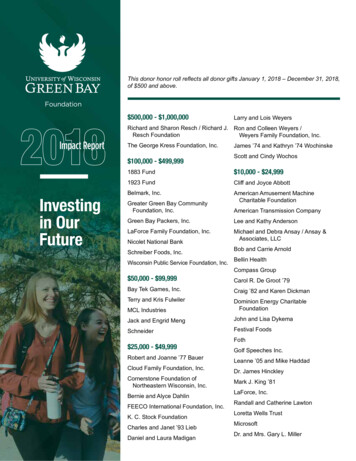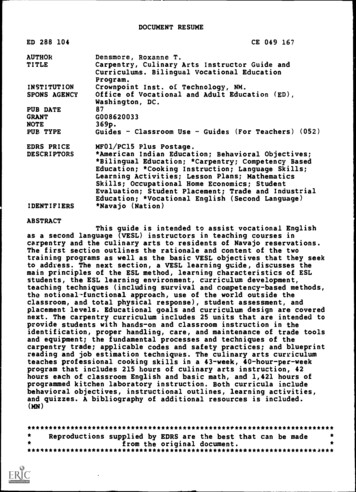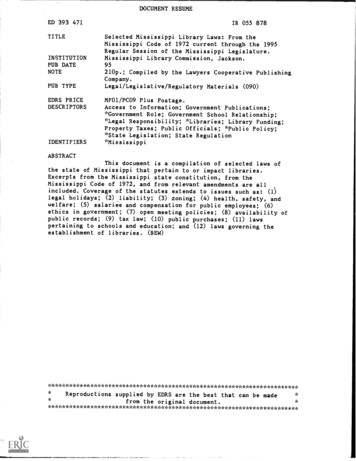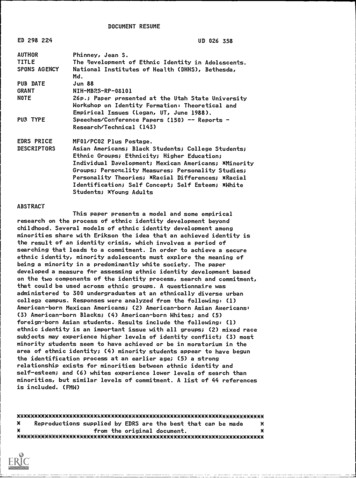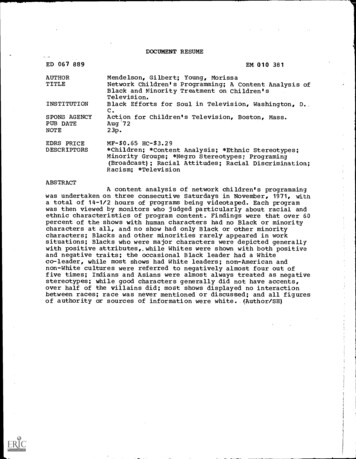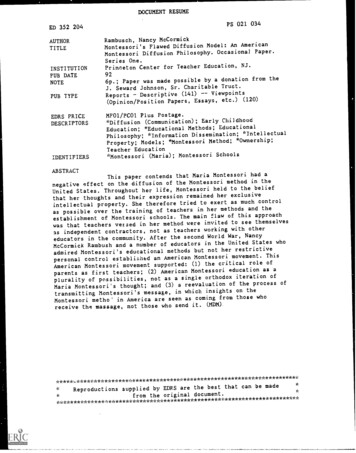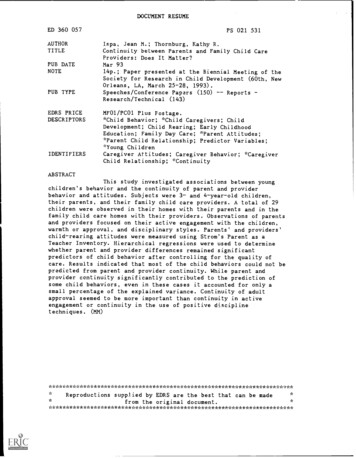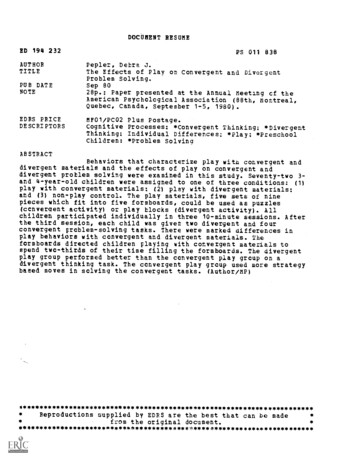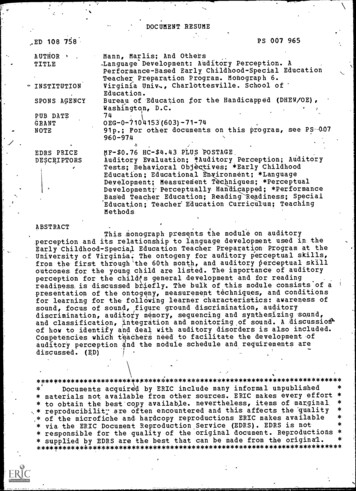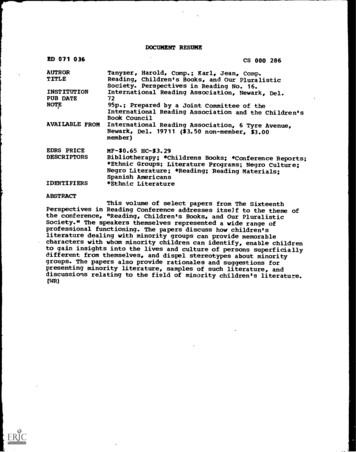
Transcription
DOCUMENT RESUMEED 071 036AUTHORTITLEINSTITUTIONPUB DATENOTECS 000 286Tanyzer, Harold, Comp.; Karl, Jean, Comp.Reading, Children's Books, and Our PluralisticSociety. Perspectives in Reading No. 16.International Reading Association, Newark, Del.72AVAILABLE FROM95p.; Prepared by a Joint Committee of theInternational Reading Association and the Children'sBook CouncilInternational Reading Association, 6 Tyre Avenue,Newark, Del. 19711 ( 3.50 non-member, 3.00member)EDRS PRICEDESCRIPTORSMF - 0.65 HC- 3.29IDENTIFIERSBibliotherapy; *Childrens Books; *Conference Reports;*Ethnic Groups; Literature Programs; Negro Culture;Negro Literature; *Reading; Reading Materials;Spanish Americans*Ethnic LiteratureABSTRACTThis volume of select papers from The SixteenthPerspectives in Reading Conference addresses itself to the theme ofthe conference, "Reading, Children's Books, and Our PluralisticSociety." The speakers themselves represented a wide range ofprofessional functioning. The papers discuss how children'sliterature dealing with minority groups can provide memorablecharacters with whom minority children can identify, enable childrento gain insights into the lives and culture of persons superficiallydifferent from themselves, and dispel stereotypes about minoritygroups. The papers also provide rationales and suggestions forpresenting minority literature, samples of such literature, anddiscussions relating to the field of minority children's literature.LWR)
U S DEPARTMENT OF HEALTH.EOUCATION A WELFAREOFFICE OF EDUCATIONTHIS DOCUMENT HAS BEEN REPRODUCED EXACTLY AS RECEIVED FROMTHE PERSON OR ORGANIZATION ORMINATING IT POINTS OF VIEW OR OPIN.IONS STATED DD NOT NECESSARILYREPRESENT OFFICIAL OFFICE OF EDLICATION POSITION OR POLICYPerspectives in Reading No. 16READING, CHILDREN'S BOOKS, ANDOUR PLURALISTIC SOCIETYCompiled and Edited byIlamld TayzerI foist ra UniversitywidJean KarlAtheneum PublishersPrepared by a Joint Committee of theInternational Reading Association and Children's Book CounciliraINTERNATIONAL READING ASSOCIATIONNewark, Delaware 19711
INTERNATIONAL READING ASSOCIATIONOFFICERS1971-1972PresidentTheodore L. Harris, University of Puget Sound,Tacoma, WashingtonPresident-electWilliam K. Durr. Michigan State University,East Lansing, MichiganPast PresidentDonald L. Cleland. University of Pittsburgh,Pittsburgh, PennsylvaniaDIRECTORSTerm expiring Spring 1 972Thomas C. Barrett, University of Wisconsin, Madison, WisconsinConstance M. McCullough, San Francisco State College,San Francisco, CaliforniaEileen E. Sargent, Nicolet Union high School. M'Iwatikee, WisconsinTprm xpiring Spring 1973Marjorie S. Johnson, templesit) Pinkijelphia. PennsylvaniaRobert Karlin, Queens College. C ity University of New York,Flushing, New YorkOlive S. Niles, State Department of Education, Hartford, ConnecticutTenn expiring Spring 1 974William Eller, State University of New York, Buffalo, New YorkWilliam J. Iverson, Stanford University, Stanford, CaliforniaEunice Slued Newton, Howard University, Washington, D.C.Executive Secretary-TreasurerRalph C. Staiger, Universityof Delaware, Newark, DelawareAssistant Executive SecretaryRonald W. Mitchell, InternationalReading Association, Newark, DelawarePublications CoordinatorPERMISSION TO REPRODUCE THIS COPYRIGHTED MATERIAL HAS BEEN GRANTEDBYInternationalReading AssociationTO ERIC AND ORGANIZATIONS OPERATINGUNDER AGREEMENTS WITH THE US OFFICEOF EDUCATION FURTHER REPRODUCTIONII OUTSIDE THE ERIC SYSTEM REQUIRES PERMISSION OF THE COPYRIGHT OWNERFaye R. Branca, International ReadingAssociation, Newark, DelawareCopyright 1972 by theInternational Reading Association,Library of Congress Catalog Card Number 77.190455
/r1ContentsContributorsivForewordvAn Overview1Harold TayzerEthnicity and Reading: Three Avoidable DangersDavid Elkind4The Black Child's NeedsGwendolyn Goldsbv Grant9The Black Child and His ReadingEthel RichardSpanish Speaking American Children and Children's Books1420Gilbert lifartiezPuerto Rican Children in the United StatesAntonia Pantoja25Who Speaks for a Culture?Pura Belpre WhiteSharon Bell MathisSandra Weiner28Arlene Harris KurtisJames C'. Gib linWe Are Still AfraidNancy LarrickWhat Are We Still Afraid Of?Peter DublinThe Minority Image in Books for Youth: Evolution and EvaluationAlice Brooks McGuireThoughts on Children's Books, Reading, and Ethnic AmericaVirginia IlamiltmiTo Humanize People or To Make The Hearts StrongRuth Kearney C'arlsonThoughts on Children's Books, Reading, and TomorrowVelma V. Varner/830343638414953616571What Does It Mean?Jean Karl80BibliographyRosemary Weber83iii
ContributorsHAROLD EANYZER is Professor of Reading at Ilefstra Univerqty and chairmanfor IRA of the IRA/C13( Joint Committee.DAVID EL KIND is Professor of Psychology and Psychiatiy at the University ofRochester and formerly served as Director of the Child Study Center at theUniversity of Denver.GWENDOLYN GOLDSBY GRANT is Associate l'rofessor at the Newark Bible College and also teaches at the Urban Institute at Montclair State College.E1IJEL RICHARD is Coordinator of the Instructional Meenal Center. Intermediate School, East Orange. N. J.-. and also teaches children's literature atNewark State College.GILBER1 NIAMINEZ is a U.S. Office of Education Fellow assigned to the Officefor Spanish Speaking American Affairs.ANTONIA I'ANTOJA is Executive Director of the Puerto Rican Research & Resources Center in Washington. D.C.PURA BELPRE wary. is the author of Pere: and Martina. Santiago, Juan Boboand the Queen's Necklace, and The Tiger and the Rabbit.SHARON BELL MATHIS is a staff member of the Washington. D.C. Black Writers'Workshop, where she teaches the writing of children's literature. She is theauthor of Sidewalk Story.SANDRA WEINER teaches photography and photojournalism at New York University and is the author of Small Hands, Big Hands and It's Wings That MakeBirds Fly.ARLENE KUIMS is the author of Puerto Ricans: Fnnn Island to Mainland andThe Jews Helped Build AmericaJAMES GIBLIN is the Editor of Books for Young l'eople for the Seabury l'ress nnNew York City.NANCY LARRICK is Adjunct Professor of Education at Lehigh University. authorof A Parent's Guide to Ouldren's Reading. and editor of six anthologies ofpoetry for young readers.PI TER DUBLIN is a free-lance writer in Boston, Massachusetts and formerly wasa teacher at the Walden School in New York City.ALICE BROOKS MeGUIRE is Associate l'rofessor in the Graduate School of Library Science at the University of Texas. and currently serves as ContributingEditor in Children's Literature for The Reading Teacher.VIRGINIA HAMILTON is the author of Zeely. The House of Dies Drear, TheTime-Ago Tales ofJandu, and The Planet of Junior Brown.RUTH KEARNEY CARLSON is Professor of Education at California State CollegeIlayward, and presently serves as Chairman of the IRA Library andLiterature Committee.VELMA V. VARNER is Editor and Director of Junior Books for Viking l'ress andpresently serves as chairman for CBC of the IRA/CBC Joint Committee.JEAN KARL is Vice President and Editor of the Children's Book Department atatAtheneum Publishers and formerly served as chairman for C BC of theIRA /('RC Joint Committee.ROSEMARY WEBER is Assistant l'rofessor in the Graduate School of LibraryScience at Drexel University and serves as a member of the IRA /OW JointCommittee.IV
iForewordThe Perspectives in Reading Conference has served as the kickoff for many ofIRA's. annual conventions and these twoday meetings have, to a large degree, setthe tone and quality of the convention proper. The Sixteenth Perspectives inReading Conference, sponsored jointly by IRA and the Childrens Book Council,was no exception; its theme was not only eye-catching but timely; the quality ofthe papers presented was superb; the audience reaction was complimentary; thequestions posed by those in attendance were probing in nature and revealedteachers' concern for the various segments of our pluralistic society.The theme of the conference, Reading, Children's Books, and Our PluralisticSociety, fits most admirably into the context of the overriding purpose of IRA,To promote the development among all peoples of a level of reading proficiency that is commensurate with each individual's unique capacity."Benefits accrued from attending this meeting were many. Yet those who didnot attend can get the flavor of the meeting by reading the papers selected forpublication by Jean Karl and Harold Tanyzer. Thew is an excellent balance ofpapers. ranging from such titles as We Are Still Afraid" to "Thoughts onChildren's Books, Reading, and Tomorrow." Implicit is a strong overtone suggesting a well-balanced literature program in the schools.Many other benefits will be realized by the reading of these papers. It will bereadily evident that literature is the medium through which the following maybe more thoroughly comprehended:I. Literature can be used to acquire new and unique insights into the heritage ofminority groups. their contributions to their own culture, and to othersegments of our society.v
2. Literature can aid in the development of imagery and imagination, but it canalso aid in the development of an appreciation for beauty.3. Literature can help in appreciating the lilt of the line, the rhythm of thelanguage, of various ethnic groups: it provides a road to the wonderland ofwords and ways of using them.4. Literature will help one become a more benevolent human being, havingcompassion and respect for all members of the human race.5. Literature has great potential value as a therapeutic agent providing unlimitedopportunities for harmonizing emotions, enabling the reader to possess himself with a full measure of quietness.6. Literature is a time machine; through and by it the child can converse withgreat personalities, living or deadpoets, humanists, dreamers, builders,philosophers. Turning the clock back, the child for a short span of time canlive in an age of his own choosing.7. Literature can become a mode of transformation. A child can become LouGehrig, Jackie Robinson, Charles Lindberg, Madame Marie Curie, LouisPasteur, Booker T. Washington, or any other international hero.8. Literature has great potential for developing wholesome attitudes towardone's self.9. Literature can be used as a means for developing wholesome attitudes towardskills and abilities; It provides ample proof that no dichotomy exists betweenthe cognitive and affective domain of the process of reading.The papers presented in this volume clearly demonstrate that each child mustbe provided ample opportunities to enjoy the fruits of having learned to read,Your thoughtful reading of this volume is invited. Not only will you find eachdiscussion to be informative, you will also enjoy the artistry of each author.Donald L. Cleland, PresidentInternational Reading Association1970-1971INTERNATIONALBOOK YEAR1972UNESCOThe International Reading Association attempts, through itspublications, to provide a forum for a wide spectrum ofopinion on reading. This policy permits divergent viewpointswithout assuming the endorsement of the Association.vi
An OverviewHarold Tany:erThe concern of the Sixteenth Perspectives Conference was with the positionsand possible contributions of children's books vis -a -vis a major question of ourtime: "Can our American democracy assume its fullest viability through itsinclusion of minority citizens?" Some of our speakers dealt with the need formaking, "invisible men" emerge in all their beauty and complexity for minorityand majority readers. Others addressed themselves to the issue of whether the"outsider" can write meaningfully of a particular ethnic/racial experience. Thefinal presentations explored opportunities for individual and societal growthinherent in the new savoring of the riches of ethnic and racial diversity.The speakers themselves represented a wide range of professional functioning.Some were members of minority groups; some were not. It should be noted thatthe scope of the presentation was limited to only a portion of the minorityspectrum in the United States. In order to keep within the confines of theallotted time and still avoid superficiality, the focus was on the two minorityexperiences that are occupying the foreground of America's consciousness: thatis, the black and the Spanish-American. Indeed, in order to be true to that partof the title which referred to "Pluralistic Society," it would have been necessaryto treat in depth the experiences of other minorities which have been cruciallyand inextricably entwined with American history. Thus, among others, theIndian, the Oriental, and the Jew have not received specific and deservedattention. It is to be hoped that this small attempt at "consciousness-raising"about certain minority groups, children, and literaaire,which was the essence ofthis Conference,will lead to a more generalized understanding and appreciationof the place of all minority experiences in education.TANYZER1
At this point 1 would like to make sonic observations about the lustor,' of theattempt to make children's literature reflect a pluralistic society. and about thehistorical context in which this movement has grown. Finally, I shall touch uponthe matter of what we may realistically expect in the way of results from thistype of literature.Although many people in education ale now male of the needachildren's literature that reflects pluralistic life, there always were a pioneeringfew who understood this need before it gained this current wide acceptance. Ii:1969 speech before the Children's Book Council, Augusta Baker described theattempts she and her colleagues made .30 years ago to compile a collection ofjuvenile books reflecting black life. Careful study beings to light years of effortby both minority and nonminority authors to idled multi-ethnic life foi :henyouthful readers.I think, however, that there can be few objections to the statement thatmulti-ethnic life was not found in the mainstream of children's literature to asufficient extent until publisheis and writers responded to a national demand foian end to the overwhelmingly lily-white, WASP, middle-class emphasis in tradebooks and most particularly in textbooks and in basal readers.These changes, such as they were, did not take place lino* calm acadt,nicinterchange but, rather, were forged in the fire of national confrontation andviolence. Let's try to trace a few of tht historical strands that have led to thecurrent situation.Although World War 11 was fought by America in the nametf democracy andself-determination of peoples, it was not until 1954 that the Supreme Courtstruck down the constitutionality of segregated school arrangements. Pion ,essimegration was painfully slow, but the early sixties presented the iniagL 4; ahopeful time in which one found blacKs and whites sitting-in, freedom-tiding,freedom-marching, and joining hands to sing "We Shall Overcome." Certainglaring and unbelievable discriminatory practices in the South were dealt a deathblow.People began to realize, however, that the main truths of intenacial relationswere to be found in the big cities which were largely in the North. By 1966 thecensus bureau was est imatolg that 69 percent of all blacks lived in metropolitanareas compared to 64 percent for whites. Puerto Ricans and Mexican-Americanswere also packed into the ghettos of the largest cities. Concuirently, middle-classwhites were fleeing the problematic cities and cleating suburbs that wcieeffectively zoned to keep out the poor. While most Americans enjoyed unpaialleled prosperity, the ghetto-dwellers found that all the civil rights legislation and"wars on poverty" made little substantive difference in filch lives.Then the plight of the ghetto-dweller was impressed upon the world's consciousness by the urban riots of 1967. The Kerner Commission was charged byPresident Johnson with the task of finding out: "What happened? Why did ithappen? What can be done to prevent it from happening again''" After intensive2Orenvew
study and exhaustive investigation. the commission arrived at this basic conclu-sion: -Out nation is moving toward two societies, one black. one whiteseparate and unequal."What does children's literature have to offer to a nation thus divided? At itsbest it can hold a mirror up to minority life and provide inemoiable characterswith whom minority children can identify. At its hest it can enable children togain insights into the lives and essential humanity of people who seem superfi-daily quite different. Any culture in the world is enormously multifaceted.There is no one white life or black life or Latin American life or Indian life thatis entirely representative of its people. Children's literature that "tells it like itis" about a culture must talk of patience and joy and triumph as well as ofviolence; pain, and despair. Children's literature, therefore. may make thedistinct contribution of dispelling stereotypes about groups.Can children's literature lead to changes in attitude on the part of the reader?What little research evidence dune is on this issue suggests that attitudes may beinfluenced b5 what children read but that we really don't know how extensiveor pet manent such influences are.Toward the end of his brief life Malcolm X said that he believed older peoplewould not get far in healing our societal wounds: but even this largely disenchanted man detected a new current 'tinning in America, and he said that hebelieved that the younger people would he the ones to make real progress.Surely all of us hope that today's children will grow up to do a better job inforging a more successful pluralistic society than we have. In a country wherethere are such massive problems of inequity, one can hardly claim that children'sliterature by and of itself can alter the course of history. However, since ourhope is that the reading of books can equip a per son to deal with life better byenlarging his understanding of himself and others. let us applaud and encouragethe current trend in children's literature toward presenting youth with therealities of our pluralistic society. It may well be that books of this type arehelping to give rise to a climate of thought and feeling that will make possiblethe development of the new and constructive changes we need so badly.TANYZI.123
'''.,asTiatIMPRIM1111-3Fatir.Etlicity and Reading:Three Avoidable DangersDark/ MindIn recent years, representatives of the field of children's books have striven to bein the forefront of the movement towards racial equality in America. Efforts toattain racial equality in children's literature have moved in two complementarydirections. One of these directions is towards eliminating from existing literaturematerials which are degrading to a particular race or which suggest derogatorystereotypes. The other movement is towards introducing black children, urbansettings, and black themes into the literature for young people.While these movements are laudable in principle, they are not always so inpractice. The fact is that we have SO little conc.ete data as to what i,. "degrading" and what is "egalitarian" that decisions in those regards are often made on apersonal and arbitrary basis. To some people, for example, Little Black Sambo isa degrading story; and at least one children's record of the story has a songentitled "Little Gray Sambo." To others, like myself, the story is not degradingbecause Sambo's failings and successes are those of all young children and arenot part of a stereotype of his race. In such cases of honest disagreement, who isto decide what is egalitarian?As a psychologist, I do not have an answer to this question, but I do knowsome of the typical dangers that occur whenever one group tries to help anotherwhich it feels it has abused and mistreated. The dangers are psychological andthreaten the success of the intended "reforms,' Accordingly, I want to stresssome of the dangers that should be avoide
GWENDOLYN GOLDSBY GRANT is Associate l'rofessor at the Newark Bible Col-lege and also teaches at the Urban Institute at Montclair State College. E1IJEL RICHARD is Coordinator of the Instructional Meenal Center. Inter-mediate School, East Orange. N. J.-. and als
